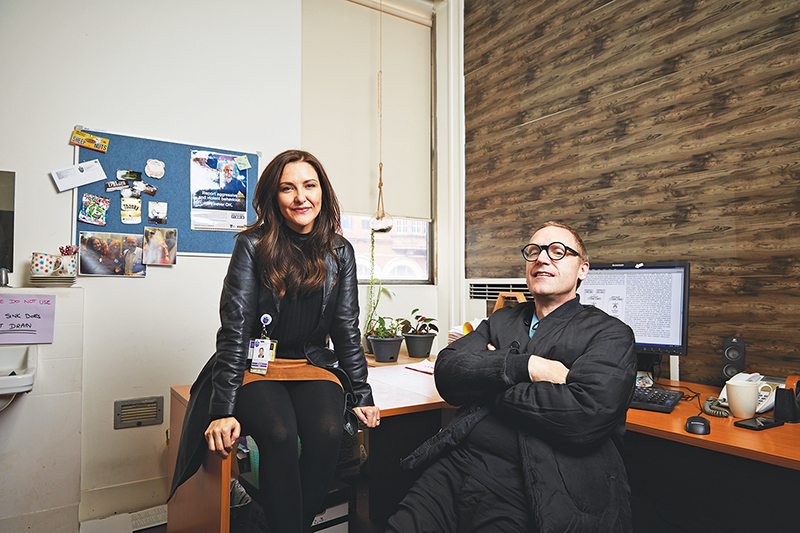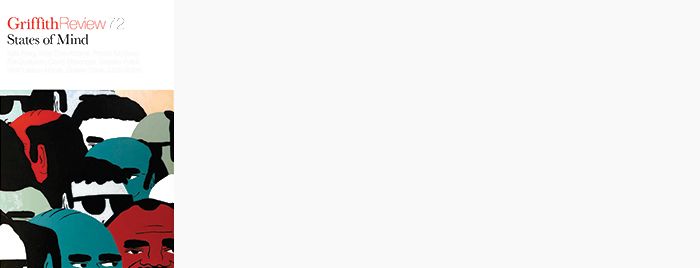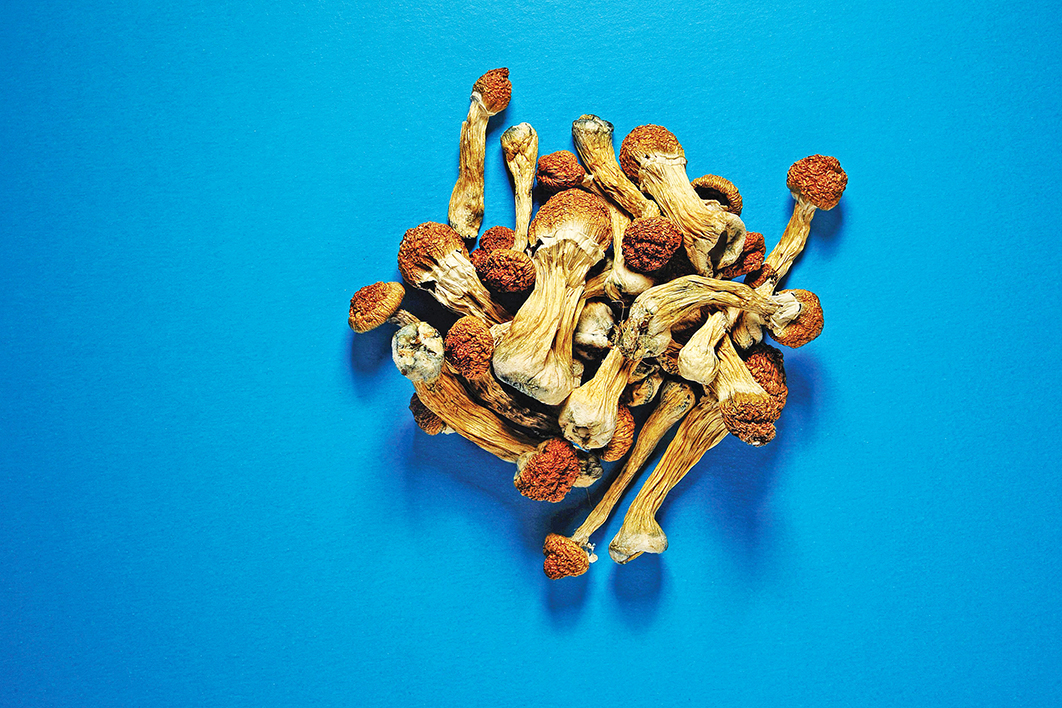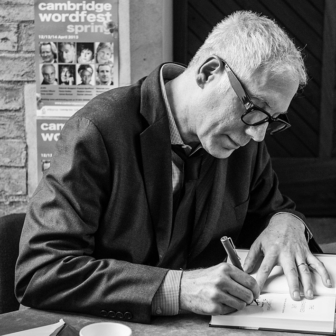March 2020. In a darkened room in a Melbourne hospital, a slight, dark-haired woman sits at the bedside of a lone patient. Outside, Covid-19 webs its way silently through the city; inside, the patient rests back on the day bed, eyes covered with a soft eye mask, ears enclosed in noise-cancelling headphones through which a specially curated playlist will rise and fall over the next six hours or so. The seated woman — watching, listening, close enough to touch — is a clinical psychologist named Margaret Ross. After eighteen months of intense negotiations, preparations, crossing of fingers and dotting of i’s, she and a colleague, psychiatrist Justin Dwyer, have just given their charge a small white capsule containing a substantial dose of the mind-altering compound psilocybin, best known as the active ingredient in “magic mushrooms.”
It is a small but historic moment. And a strange one. Psilocybin and the fungi from which the compound is derived have been used in shamanic and other Indigenous rituals for centuries. The mushrooms are said to be depicted in artworks thousands of years old. They have been consumed by hippies in the Summer of Love, decried by former US president Richard Nixon and eventually outlawed. They have even informed their own theory of human evolution (US ethnobotanist Terence McKenna’s ‘Stoned Ape Theory’). But today they are being harnessed by Western medicine to try to ease the terror of dying.
The figure on the day bed is the first of about thirty-five desperately ill patients who, with the help of Ross and her team, will each take a legal psilocybin trip (sometimes two) as part of the nation’s first approved randomised controlled trial of psychedelic psychotherapy. In fact, only two patients will go through the treatment early in 2020. And then suddenly it will all stop. Four days later, Ross will be back on the ward, in scrubs, counselling traumatised staff about how to care for patients, families and themselves as Melbourne enters its first lockdown. But what she sees in those extraordinary days before the trial is suspended will change the way she thinks about her work, her patients and the possibilities for treating some of the country’s saddest and sickest people.
So, definitions. Psychedelic therapy (psychedelic: from the Greek roots of “mind” and “manifesting’) first emerged as a subject of clinical research in the US in the late 1940s, with the release of the mind-altering, era-defining hallucinogen lysergic acid diethylamide, or LSD. During the 1950s and ’60s, tens of thousands of people took LSD — marketed initially as a cure for mental disorders from schizophrenia to “sexual perversion” — as part of the first wave of psychedelic research, before the drug, and psychedelics generally, fell victim to the social and political upheaval of the times. These days researchers prefer to focus on psilocybin — which is less potent than LSD and less stigmatised — as well as MDMA (“ecstasy”), which while not technically a psychedelic does some similar things to the mind, seemingly by lowering defences and promoting new ways of thinking. Researchers also prefer to talk about “psychedelic [or psychedelic-assisted] psychotherapy,” to emphasise that the drug treatment is securely corralled in a series of counselling sessions.
For those who give the topic any thought (I get mainly blank looks when I raise the subject with medical acquaintances), attitudes towards psychedelic psychotherapy range from dismissive to evangelical. In one iteration it is an undercooked, overhyped, potentially dangerous fringe treatment that could divert desperately needed funding from other areas of the already stretched mental health budget. In another, it is a paradigm-shifting therapeutic frontier that could reconfigure Australia’s treatment of hitherto intractable mental conditions — such as deep, persistent depression and post-traumatic stress — within a decade and also transform our approaches to other illnesses, including addiction, anorexia and obsessive-compulsive disorder.
There is another option that gets less airplay, but that is worrying psychedelic researchers here and worldwide. More on that later.
For now, and after a slow start — “We are very conservative in the research area; we’re a very conservative country,” says one researcher — Australia is turning towards psychedelic drugs to help treat some of our most entrenched and distressing mental illnesses. In November 2020, researchers at Melbourne’s Monash University announced the university would sponsor two new trials: one a large, world-first study of psilocybin to treat crippling anxiety; the other exploring the role of MDMA in treating severe post-traumatic stress disorder, or PTSD.
Several smaller trials are also ready to go, including a partnership between Melbourne’s Swinburne University and St Vincent’s Hospital that will study the impact of psilocybin-assisted psychotherapy on treatment-resistant depression; another on the role of MDMA in treating PTSD from Perth’s Edith Cowan University; and one from St Vincent’s Hospital Sydney on methamphetamine addiction. Other psychedelics of interest include the South American brew ayahuasca and its potent active ingredient, DMT.
Those involved in the trials hope they will lay the groundwork for psychedelic psychotherapy to one day become an approved, Medicare-funded treatment for thousands, maybe tens of thousands, of Australians whose mental conditions are resistant to conventional treatments, and whose daily lives span a continuum from distressing to unendurable.
But they warn that getting there will be difficult. Nor is it guaranteed. Along with the usual logistical and regulatory juggling over the approval of any new drug are personal, professional and political faultlines that must be navigated if Australia is to achieve a workable model of psychedelic psychotherapy (even now the temptation is to overlay the words in retro colourways). And before and beyond all that is the sheer mind-bending otherness of the experience at the heart of the proposed new therapy — an experience only partially amenable to language, which scientists in respected journals describe as “ineffable,” “mystical” and “transcendent,” and one that is embedded in a process that can involve a profound reckoning with the self and its place in the world.
“The psychedelic experience can open people up to long suppressed feelings both negative and positive,” says a 2020 paper from Rosalind Watts of London’s Imperial College. “It can involve peak experiences, mystical states, and experiences of intense, all-encompassing love and bliss.”
And from this flow great possibilities and great challenges.
In a noisy outdoor cafe opposite the hospital, Margaret Ross is searching for words. “There’s times when I have to really sit and percolate on an idea and kind of really, really feel it in my bones before I give a thoughtful answer.” She listens attentively, laughs frequently, talks in flurries. But she knows that talk only gets you so far.
Ross has spent much of her life among the dying. At seven, she was deeply affected by the death of a beloved grandmother. As a clinical psychologist working with palliative care patients, many from the St Vincent’s cancer wards, she has spent years thinking about how best to help people who can no longer be helped — at least not in the way that most of us entering a hospital want to be helped. She has researched the psychological impact of cancer and other terminal diagnoses. She has seen some remarkable deaths.
And she has seen a lot of fear. The publicity material for the Melbourne trial describes the “depression” and “anxiety” of some terminal care patients — words that seem barely to touch the sides of what Ross encounters in her work. First, she says, is the fear of death itself, the “annihilation of self.” Cascading from this central void is grief at leaving behind a partner, a sister, a child (“especially children”) and fear for their welfare in a world where you will no longer be there to love or protect them. Then there is the physical and mental dismantling that is the dying process (“Will there be pain, indignity, will I lose control?”). And fears about the relentless, incremental losses that define a terminal diagnosis: identity, independence, relevance, control. Even as a therapist, says Ross, it is hard sometimes not to feel helpless. “I see so much terror and distress.”

“We set up a kind of little camp”: Clinical psychologist Margaret Ross and her colleague, psychiatrist Justin Dwyer. Kristoffer Paulsen/Nine
When Ross was sixteen, her mother was diagnosed with a serious respiratory disease. She fought it for a long time and died when Ross, the youngest of five sisters, was twenty-seven. “She never really made peace with it. She loved life too much. She didn’t want to leave her girls… And she was absolutely terrified of death. So I’ve had an interest in death, the way people square with it, for a very long time.”
As a young psychologist, says Ross, she started thinking about the therapeutic potential of altered states such as meditation and yoga. She trained in hypnotherapy. Anything that might help people find a way through. When a new wave of international research into the therapeutic potential of psychedelics started emerging in the early 2000s, she paid attention. More so when, in 2016, two key studies came out of the US on the impact of psilocybin-assisted psychotherapy on the mood and attitudes of patients with life-threatening cancer. The results, she says, were “staggering.” The trials, one from New York University and the other from Johns Hopkins University in Baltimore, found rapid, sizeable reductions in depression and anxiety that for many would go on to last six months or more.
It was what Ross had been looking for. A way in.
Like most of those I have met in researching this article, Paul Liknaitzky confounds lingering stereotypes of the “turn on, tune in, drop out” variety. Neat, articulate and with a sentence structure girdered in careful clauses and subclauses, he could be a rising public servant. He is also determined. As a teenager he navigated solo through a series of distressing psychological episodes — “spontaneous and terrifying altered states of consciousness,” he calls them — eventually breaking the cycle by standing in front of a mirror, staring into his own eyes (“If I die, I die”). Which may help explain his centrality in the emerging framework of an Australian psychedelic therapy.
Margaret Ross describes him as the “mycelial network” of Australia’s psychedelic research world, referring to the underground web of microscopic fungal fibres that link and sustain diverse communities of plants. A research fellow at Monash University, he is co-ordinator of the St Vincent’s trial, and chief principal investigator on the upcoming Monash trials as well as several others now taking shape in the fertile loam of Australia’s nascent psychedelic research landscape.
The possibilities, he says, are astonishing. “There is uncharted territory wherever I look.”
Admittedly, any discussion of the potential benefits of psychedelic drugs in treating mental illness takes as its baseline the shortcomings of existing pharmacological models. The 2020 Productivity Commission Inquiry Report into Mental Health estimates the economic costs of mental illness and suicide at up to $70 billion per year in Australia, plus another $150 billion or so in reduced health and life expectancy. The most common drug treatment for depression, selective serotonin reuptake inhibitors, has been shown to help only about half of patients, with high relapse rates after discontinuing and no major breakthroughs in more than thirty years.
“That indicates to me that we have some fundamental assumptions about mental illness that are wrong,” says Liknaitzky.
Even measured against that relatively low base, the early indications for the potential of psychedelics — across a wide and growing range of mental disorders — has been galvanising.
In the past two decades, studies have shown significant, sometimes startling, improvements in conditions including death anxiety, treatment-resistant depression and PTSD. In recent years, high-profile psychedelic research centres have opened in major universities, including Imperial College and Johns Hopkins, as well as in Basel and Zurich. The US Food and Drug Administration has designated MDMA therapy for PTSD, and psilocybin therapy for depression as “breakthrough therapies.” One recent study using psilocybin to help treat long-term depression reported an effect around four times that of traditional antidepressants.
One of the primary claims made by researchers in the field is that unlike drugs such as antidepressants, psychedelics are not treating symptoms but root causes often related to childhood or other trauma. While it may be decades (or longer) before we truly understand the brain mechanisms by which psychedelics exert their disorienting effects, recent research suggests that psilocybin quietens a brain region called the default mode network, which includes the circuitry involved in how we remember our lives, and the stories we tell ourselves about who we are. In classic psychoanalytic terms, it seems to dial down the ego, lowering our psychological defences, helping us to think in more open and flexible ways, and increasing our sense of connection to ourselves and others.
“The opportunity there is for patients to consolidate aspects of themselves or their lives that have been repressed,” says Liknaitzky, “to gain new and helpful perspectives on old problems, and to feel, emotionally, a much stronger alignment with their values and what’s important in life — and to be motivated to act in accordance with [those] values.”
Of course, these sorts of insights, the ability to access and recast buried thoughts, memories and feelings and to change our behaviour accordingly, are the goal of much psychotherapy, as well as a benefit of some meditative practices. But psychedelics seem to turbocharge that process. And unlike some of the hard-won insights that arise through talk therapy, Liknaitzky suspects that the fundamental alteration psychedelics bring about is not a thought or idea, but “an embodied encounter or a revelation.” And that this suggests a greater possibility of long-term change, at least for some.
I speak with “Clare,” a social worker who tried psilocybin last year in a bid to overcome a debilitating, corrosive lack of confidence — she calls it “imposter syndrome” — that was affecting her personal life and interfering with her work. She took the drug illegally, though with the support of a trained therapist with an interest in psychedelic medicine and, she says, a lot of preparation. She describes a series of discrete scenes, each like a small film: an emotional encounter with her estranged mother; a vision of her seven-year-old self; a meeting with a large benign rat; and finally, herself, in a room, surrounded by family and friends, able in this moment to see herself through their eyes. “And it was just — it was full of love. And I felt like my heart was gonna burst with love and pride. For myself.” She says the experience has changed her understanding of childhood trauma and taught her what “self-care” really means — changes that have flowed into all aspects of her life. “It was one [of]…if not the most significant experience in my life.”
“People report a verisimilitude,” says Liknaitzky, “which is that your representation of reality seems to be more reliable than your sober one. And that’s a striking experience. It’s as though you’ve woken up from the dream of your life.”
Admittedly, he says, for the most part the insights that come out of the psychedelic experience sound like platitudes. “I mean you can pop them on a Hallmark card. You know, ‘love is all there is.’ Actually, what matters is that if you can genuinely feel that love is all that matters, then that is absolutely profound. And you can’t talk yourself into feeling that. You can’t talk yourself easily into feeling compassion for an abusive mother, for example, but once you’ve actually had that encounter, then you’ve got a possibility of having quite a different relationship to whatever was disturbing you.”
The trial takes place in the retreat room at St Vincent’s Cancer Centre, fitted out with the daybed, warm furnishings and, on dosing days, pot plants and an Indigenous painting that Ross brings from home. “It’s a lovely space.” The study follows the design and protocols of those two key US studies from 2016.
In the lead-up to this day, Ross and psychiatrist Dwyer, who is co-principal director on the trial, have interviewed eight patients, eager — some desperate — to participate, assessing their physical and mental suitability, as well as excluding anyone with a history of psychosis, bipolar disorder or some types of complex trauma — all of which can be aggravated by psychedelics. Many don’t make it through this initial screening. Others do, but later deteriorate. Some die. “Things can happen, and they have happened,” says Ross. “People can be devastated.”
Crucial to the emerging treatment are the so-called ‘set and setting’ protocols identified in the first wave of modern psychedelic research and refined in the past two decades: the mindset and intentions you bring to the experience, and the setting in which it takes place. One of the striking features of psilocybin is that its benefits are related to the nature of the experience you have while taking it. Feelings of awe and transcendence have both been linked to improved outcomes in trial participants. At the same time, the experience is powerfully contingent on the environment and atmosphere within which people take the drug, the preparation they have had leading up to taking it, and their relationship with the therapists who will be supporting them before, during and as part of the crucial consolidation period afterwards.
The difference between a “bad trip” and a challenging but rewarding trip is mainly preparation and consolidation, says Ross. She recently came across an analogy she likes: “It’s the psilocybin experience that kicks the doors open. What you do with it after that is up to you.”
On the day of the drug treatment, she says, the therapist’s role is largely hands-off. She and Dwyer will sit with their charge and pay close attention to their emotional and other reactions; they will help or comfort if needed, but generally won’t intervene unless invited (a reassuring word, a glass of water, a hand to hold.) The music seeps into the room as well as the patient’s headphones, providing an intense, evocative soundtrack. “I can’t articulate how much more raw and stripped back you feel as a therapist.”
Patients arrive at 8.15 am. They are invited to bring with them personal items of significance, talismans that might help them feel safe or remind them of what is important to them. “We set up a kind of little camp,” says Ross, “because we’re there for hours.” Dwyer checks their blood pressure and heart rate, which will be monitored throughout the session. (While psilocybin so far appears reassuringly safe overall, physical side effects can include raised blood pressure, nausea or headaches, although these are generally short-lived.) They chat. Patients revisit their intentions for the trip, what they hope to explore. And Ross might remind them of the poem they talk about during the sessions leading up to “dosing day’: “The Guest House” by Persian poet and mystic Rumi:
This being human is a guest house.
Every morning a new arrival.
A joy, a depression, a meanness…
Welcome and entertain them all!
Central to the emerging model of psychedelic therapy is a confronting and not very fashionable idea: this treatment may at times be difficult; it may be painful; you may be afraid.
From a gently swaying houseboat on London’s River Thames, Rosalind Watts talks about “moving into the darkness.” One of the rising stars of the UK’s psychedelic research sphere, Watts has thought a lot about how to prepare therapists and patients for a paradigm based on the acceptance of psychological pain in a culture that routinely prioritises numbing.
“It’s like seasons,” she says “It’s darkness and light. And in our culture, it’s very much about — it should always be summer, you know, everyone should be happy, we should be busy, we should be productive, avoid the darkness… keep it light.”
But it is in accepting the darkness, she says, that her patients have a chance to heal.
She understands that some will simply not want to undertake a disorienting, sometimes gruelling, interior journey during which, even under ideal clinical conditions, nearly a third of volunteers can experience “significant fear,” albeit transient, according to a recent US study. “It won’t be for everyone.”
But for those who do, she says, the results can be transformative.
Until recently, Watts was a clinical psychologist at Imperial College, leading a major study comparing the impacts on depression of psilocybin versus a conventional antidepressant. Those results had not been published before this article went to print. But a smaller feasibility study reported striking reductions in treatment-resistant depression and later helped inform Watts’s development of a framework to help therapists prepare patients for the psychedelic journey. (‘Without a framework a psychedelic experience can be kind of like a nebulous dream.”) Her “Accept, Connect, Embody” model encourages patients to visualise diving into the ocean to the seabed to find oysters containing hard and difficult things.
Back in Melbourne, the St Vincent’s team use different metaphors, though with the same aim (Margaret Ross is a fan of Watts’s work). While the decision is always for the patient to make, says Ross, her counsel — as they prepare to enter the unknown — is to invite in whatever they most want to turn away. And to surrender.
“You might experience bliss,” she says, “you might experience oneness with the universe. You may feel your body like it’s dissolving or warping. Or, you know, it might feel quite scary. Don’t worry, your heart is still going to beat, your lungs are still going to breathe. It may feel like you’re dying, you may feel like you’re going crazy, and it’s okay.”
But outside the small, still room in Fitzroy, pressures are building.
In December 2020, an online opinion piece in the prestigious Journal of the American Medical Association Psychiatry issued an unambiguous warning about the future of psychedelic research. Despite — indeed because of — the promising results of recent clinical trials and the “seemingly exceptional potential” of the treatments, the so-called renaissance in psychedelic research was at risk of being derailed. The same sorts of “exuberance, utopian thinking, and uneven clinical approaches” that had led to the banning of these substances in the 1960s, “combined with the contemporary tendency to politicise science,” could do the same again, depriving potentially millions of people of future treatments.
The authors — one of them the world-leading researcher and founder of the Johns Hopkins Center For Psychedelic & Consciousness Research, Roland Griffiths — called for more studies into the drugs’ mechanisms and risks, as well as into how best to administer them in hospitals or other clinical settings. Psychedelics, they warned, were neither a quick fix nor a panacea.
Most of all, they called for restraint.
A similar conversation is now happening in Australia. “Understandably, there’s a lot of pressure to get the treatment out there as quickly as possible,” says Melbourne psychiatrist Nigel Strauss. “But really, we’re not ready for that yet.”
A prominent trauma therapist, Strauss has worked with survivors of Tasmania’s Port Arthur massacre and Victoria’s 2009 Black Saturday bushfires. He also has a longstanding interest in the therapeutic potential of psychedelics. Now in his seventies, he travelled to the UK in 2014 to do the MDMA therapy training program run by the pioneering Multidisciplinary Association for Psychedelic Studies. Last year, MAPS released follow-up results of phase 2 clinical trials of MDMA-assisted psychotherapy for PTSD showing that 56 per cent of participants no longer met the criteria for the disorder two months after treatment, with two-thirds of those still clear after a year or more. Phase 3 trials are now underway, amid building hopes that the drug might be approved for medical use in the US this year.
Strauss has personally funded most of the pending Monash PTSD study and is set to head the upcoming Melbourne trial of psilocybin for intractable depression. But he too urges restraint. “The last thing we want is for mistakes to happen.” Last year he set up a group of like-minded psychiatrists, Australia New Zealand Psychiatrists for Psychedelic-Assisted Psychotherapy, to discuss and prepare for the possibilities and challenges ahead.
There is no shortage of challenges.
Some relate to gaps in the knowledge. How does it work, for instance? How to more accurately gauge who is or isn’t a suitable candidate for psychedelic therapy? Why do some people have life-changing experiences while others don’t respond at all? How to minimise the risk of retraumatising already vulnerable patients?
Some are to do with questions of access and equity: how to ensure that those most in need will get to use the treatments — not just the wealthy, white and connected?
Other questions arise from the curious nature of the relationship between the drug, the person taking it and the therapeutic framework within which it is taken. There are harrowing accounts of patients emerging from deep and chronic depressions after psilocybin treatment, only to relapse months later. Paul Liknaitzky wants to know more about dosing regimens — how often, how much? — and is also keen to explore ways of prolonging the benefits of the “psychedelic encounter” by combining it with other mind-altering practices. “It’s not a drug you can take home. It’s a drug that needs a lot of support,” he says.
This puts particular demands on the therapists who might someday administer these therapies.
It is also one source of a growing rift between sections of Australia’s psychedelic research community and the high-profile, Melbourne-based advocacy and education group Mind Medicine Australia, or MMA. Launched as a charity in 2019 by philanthropist and opera singer Tania de Jong and her investment banker husband Peter Hunt, MMA promotes the use of medically controlled psychedelic-assisted treatments with a focus on psilocybin and MDMA to help counter the rising toll of mental illness. The couple founded the organisation following their own transformative psilocybin experiences (they travelled to the Netherlands, where they could legally take the drugs with a private therapist), and subsequently provided some early funding to Margaret Ross’s study via the charity Psychedelic Research in Science & Medicine.
Recent MMA projects include seeking to reschedule psilocybin and MDMA from prohibited substances to controlled drugs under the Poisons Standard — a move that could also make it easier for doctors to seek special access to the drugs for individual patients under a scheme already in use for medicinal cannabis. The MMA website has published moving extracts from dozens of submissions from patients and mental health professionals supporting the change — including one from de Jong herself, who is the daughter of Holocaust survivors. But critics in the psychedelic research community (even some who don’t believe the drugs should have been scheduled in the first place) argue that efforts to expedite the therapy are premature and potentially risky. In February, the Therapeutic Goods Administration delivered interim decisions acknowledging “significant public support” for rescheduling both substances but opposing the moves at this stage, citing “the risks to consumers, the lack of training for physicians, and the current state of research.” A final decision was due in late April.
Meanwhile, MMA is this year rolling out its own Certificate in Psychedelic-Assisted Therapies. According to its website, the $7,500 four-month course — available to experienced mental health practitioners, including social workers and occupational therapists — will take in components from overseas courses, input from local and international trainers and experts, and workshops, one of which will offer participants experience with breathing techniques designed to induce altered states. However, trainees cannot currently legally use or work with psychedelic substances, or administer them to patients.
Nigel Strauss and Paul Liknaitzky contend that, at least initially, all training should take place within clinical trials overseen by experienced international clinicians and be limited to psychiatrists, psychologists and psychotherapists. Liknaitzky has been developing a program to provide on-the-job training initially for around thirty therapists who will work on the Swinburne and Monash trials and who, he says, will later be able to train others. “These trials are an opportunity to train therapists ethically and rigorously through expert supervision, with real patients, using these drugs.”
Five of those I interviewed for this piece, including Liknaitzky, Strauss and PRISM’s Martin Williams, have quit MMA positions in the past eighteen months. Among the latest to go is British psychologist Renee Harvey, a highly qualified clinician who has worked on psychedelic trials at Imperial College, and who MMA hired to set up and run their training program. Harvey would not discuss her time at MMA or her sudden departure, except to say that she was happy for it to be known that she had resigned.
The broader arguments are at times confusing and/or personal, but seem largely to boil down to disagreements over the pace and process of change.
“More research on psychedelics would be brilliant,” says MMA’s Peter Hunt. “But the question that we all have to face up to is, when do you actually allow these medicines to be used for people that are suffering? In other words, when is the evidence sufficiently good to warrant any residual risk you’re taking by using these medicines with patients?” Given proper screening, support and medical controls, he says the time is about now. He points out too that antidepressants carry their own risks.
The outgoing head of psychiatry at Melbourne University and St Vincent’s Health, Professor David Castle, has his own concerns. Speaking generally, he says: “The worry, I suppose, with the field is that some people have sort of leapt ahead of the evidence… And actually, you know, if you look at the scientific evidence, it’s relatively light on. It’s hugely exciting, but in terms of an evidence base, it’s very small.” Castle, who is leaving Australia to take up a position at Toronto’s Centre for Addiction and Mental Health, is a former board member of MMA. He hopes to pursue his interest in psychedelic research in Canada.
There is fear on both sides. On the one, that research and approvals will come too late for people who are barely hanging on. On the other, that without a rigorous, transparent scientific process that focuses on the local landscape as well as connecting Australia to the international research effort, the risk of mistakes rises, and with it the spectre of the research once more going off the rails.
John Allan, president of the Royal Australian and New Zealand College of Psychiatrists, is a cautious voice. Despite some promising results, he says, the research is in its early stages. “There is a history of controversies involving supposedly game-changing psychiatric treatments that, despite best intentions, have been based more in enthusiasm and hope than in rigorous research, and have ended up doing harm to people and to the future of psychiatric treatments.” He says the college is open to new treatments that improve lives, and that Australia’s research is of high quality. “But we just have to be really careful. And we have to do the science properly.”
There are bigger questions too — that go to the heart, perhaps the soul, of the psychedelic experience. But these are questions for later.
Ona mild, sunny Melbourne day in January 2021, ten months after the historic psilocybin trial was suspended, Marg Ross is back at her desk in St Vincent’s Hospital. In front of her is a list of names of patients who had originally expressed interest in the trial. “Inevitably we will have lost some,” she says. But today she will start making calls.
It will be another three or four years before the trial is completed, and at least a year before interim results are available. And even then, she says, she will need to protect the privacy of her patients. There is a lot she can’t say.
However, reports from patients from the 2016 New York University study give a sense of the range and intensity of their experiences. A subsequent qualitative study describes participants’ “exalted feelings of joy, bliss, and love; embodiment; ineffability; alterations to identity; a movement from feelings of separateness to interconnectedness; experiences of transient psychological distress; the appearance of loved ones as guiding spirits…”
“I feel like a whole bunch of crap has been dumped off the surface,” said one woman, who until her psychedelic experience had been just watching “the clock numbers ticking by.” Now, she said, “ just watching that tree over there blowing in the breeze, seeing people in the street, and all the different people in vehicles rushing by! I just feel good about being alive.”
What Ross can say is that the experience of sitting with her two first patients was profound — she uses the word repeatedly, apologising for doing so. She uses the words “extraordinary” and “stunning” too. She talks about learning to trust the deep inner wisdom — the “genius” — of the patient. She says that more than once the experience brought tears to her eyes. That seven weeks after one of those early sessions, she came across a researcher who had just done a follow-up interview and was now weeping in the corridor.
“I said “Are you all right?” and she said, “Yep.” And then she teared up and said, “It was beautiful.”’
Ross hopes that in time her study will lead to other, larger trials, involving more patients and more therapists, and helping link Australia to the international effort to rehabilitate psychedelic therapy. Her hopes were boosted in March when Minister for Health Greg Hunt announced a $15 million grants package to research breakthrough therapies including psilocybin, MDMA and the dissociative anaesthetic ketamine for treating debilitating mental illness.
“This is such a fragile re-entry back into medicine,” says Ross more generally. “We’ve got one shot at this and that’s why it will take the time that it takes — because it is so easily demonised. You need one bad experience that’s highly publicised, and then we are back at square one. You’ll see a very, very public and swift political backlash, like we did in the seventies. And then it’s all off.” She picks up the phone. By mid-afternoon she has made her first appointment. All going well, two weeks from now she and Dwyer will sit beside their patient and hand them a small white capsule. After that, who knows? “What they can experience is visceral,” says Ross. “And then that transcendent state which is really intangible. To see someone going through that is just something else. I don’t have —” She pauses, half-laughs. “No words. Enormous privilege is what comes to mind.” •

This essay first appeared in GriffithReview72: States of Mind, edited by Ashley Hay.




